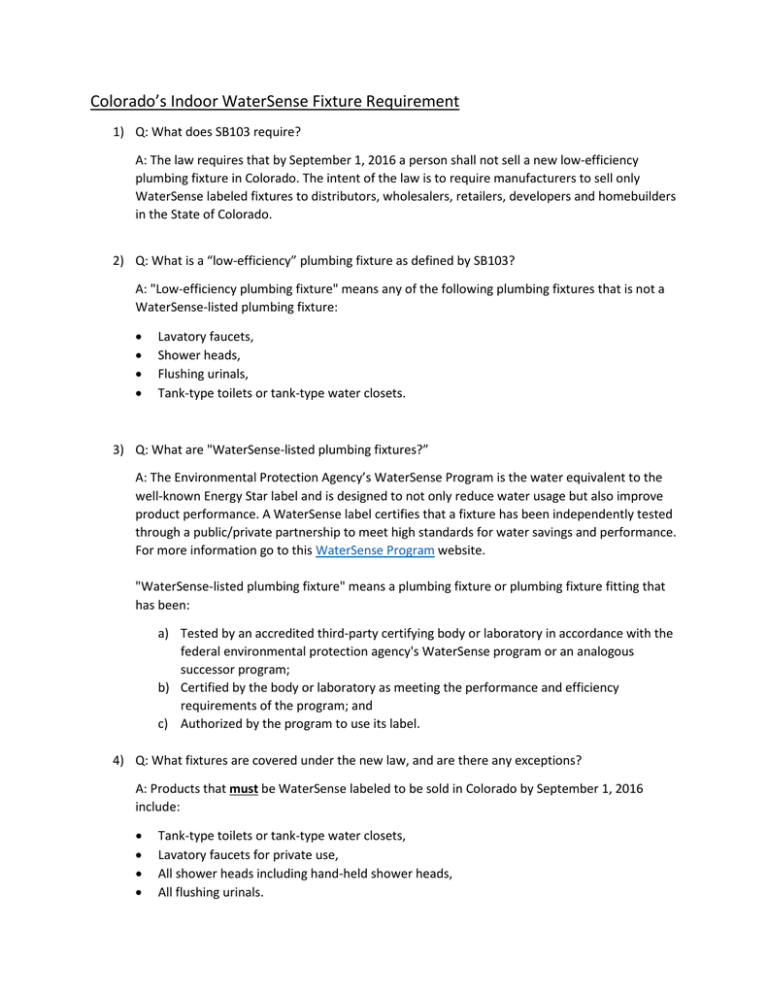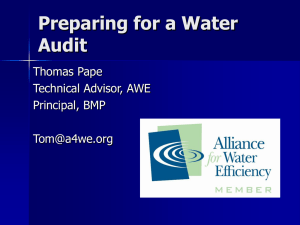Colorado`s Indoor WaterSense Fixture Requirement
advertisement

Colorado’s Indoor WaterSense Fixture Requirement 1) Q: What does SB103 require? A: The law requires that by September 1, 2016 a person shall not sell a new low-efficiency plumbing fixture in Colorado. The intent of the law is to require manufacturers to sell only WaterSense labeled fixtures to distributors, wholesalers, retailers, developers and homebuilders in the State of Colorado. 2) Q: What is a “low-efficiency” plumbing fixture as defined by SB103? A: "Low-efficiency plumbing fixture" means any of the following plumbing fixtures that is not a WaterSense-listed plumbing fixture: • • • • Lavatory faucets, Shower heads, Flushing urinals, Tank-type toilets or tank-type water closets. 3) Q: What are "WaterSense-listed plumbing fixtures?” A: The Environmental Protection Agency’s WaterSense Program is the water equivalent to the well-known Energy Star label and is designed to not only reduce water usage but also improve product performance. A WaterSense label certifies that a fixture has been independently tested through a public/private partnership to meet high standards for water savings and performance. For more information go to this WaterSense Program website. "WaterSense-listed plumbing fixture" means a plumbing fixture or plumbing fixture fitting that has been: a) Tested by an accredited third-party certifying body or laboratory in accordance with the federal environmental protection agency's WaterSense program or an analogous successor program; b) Certified by the body or laboratory as meeting the performance and efficiency requirements of the program; and c) Authorized by the program to use its label. 4) Q: What fixtures are covered under the new law, and are there any exceptions? A: Products that must be WaterSense labeled to be sold in Colorado by September 1, 2016 include: • • • • Tank-type toilets or tank-type water closets, Lavatory faucets for private use, All shower heads including hand-held shower heads, All flushing urinals. Products that do not need to be WaterSense labeled to be sold in Colorado after September 1, 2016 include: • • • • • Composting toilets, and flushometer or valve type toilets Residential kitchen faucets and metering faucets, Lavatory faucets for public use, Metered fixtures and fittings Non-water urinals. 5) Q: What is a “tank-type toilet” or water closet? A: A tank-type toilet is any toilet that uses a tank of water to effectuate the flush. These do not include flushometer valves, which are toilets that use a valve to control the flush of a toilet which are more commonly found in commercial settings. 6) Q: What is the timeline for the implementation of this law? A: The requirements and implementation timeline are as follows: a) On September 1, 2016 no person shall sell a new low-efficiency fixture as defined above in Colorado, b) By March 1, 2017 manufacturers need to file a one-time report specifying the percentages of low-efficiency and WaterSense fixtures by the four categories they sold in Colorado in 2016. 7) Q: What information do manufacturers need to report? A: By March 1, 2017 each manufacturer that sells lavatory faucets, shower heads, flushing urinals, tank-type toilets and water closets shall file a report with the Colorado Water Conservation Board that states the percentage, by category, of its sale in Colorado during 2016 of each category of plumbing fixtures including: a) Low-efficiency plumbing fixtures as defined by the law, and b) High-efficiency plumbing fixtures as defined by the law. 8) Q: How does a manufacturer file the one-time report? A: The Colorado Water Conservation Board will provide a link on this webpage to a simple, onetime online form. If you are required to file a report, please return to this page after December 31, 2016 and before March 1, 2017. 9) Q: The law says, “Effective, September 1, 2016 a person shall not sell a new low-efficiency plumbing fixture in Colorado.” At what point in the sales process does it count toward the effective date? A: The effective date applies to direct purchases or purchase orders made on or after September 1, 2016. It does not apply to delivery or installation dates. It is only if you purchase or have created a purchase order on or after September 1, 2016 that the new law would apply. Examples include: • • • This new law does NOT apply if a customer such as a retailer, distributor, wholesaler, or contractor has created a purchase order with a manufacturer on August 1, 2016 for lowefficiency water fixtures but the fixtures will not arrive or be installed until after September 1, 2016. This new law DOES apply if a customer such as a retailer, distributor, wholesaler, or contractor has created a purchase order with a manufacturer on or after September 1, 2016 for covered fixtures. In this case the manufacturer shall only sell WateSense labled water fixtures as defined by the law. This new law does NOT apply if a construction contractor places a purchase order for covered fixtures for a project before September 1, 2016 and the fixtures will not be delivered and installed until after September 1, 2016. 10) Q: Does this law require that existing homes and buildings must be retrofitted prior to sale? A: No. This applies to “new” fixtures only. Existing fixtures in buildings present at time of sale of the building would not be included. 11) Q: What can or should retailers, wholesalers, distributors, developers, contractors and home builders do? A: Familiarize yourselves with WaterSense products and begin placing orders for WaterSense products so that you are ordering the right products by the September 1, 2016 implementation date. 12) Q: Where can I go if I have more questions about the specific WaterSense products covered in the new law? A: WaterSense has detailed information on each fixture that can be found here: • • • • Showerheads Faucets Tank-type toilets Flushing urinals 13) Q: What if I buy the product from an out of state company and have it shipped to Colorado? A: Regardless of where the product originates, if shipped to anywhere in Colorado, it would be subject to this law. 14) Q: Can a distribution center located in CO purchase low-efficiency water fixtures and then sell them outside of Colorado under this new law? A: YesNo. The law applies to all sales that originate in the State of Colorado for fixtures that will be installed in Colorado. If the distribution center is shipping for installation outside of Colorado, this law does not apply. 15) Q: Flushometer valves now have a WaterSense specification, so are they now covered by SB103? A: SB103 only applies to tank type toilets so that these toilets must have a WaterSense specification. SB103 did not include flushometer valves for toilets but the recent adoption (December 2015) of a flushometer valve WaterSense specification for toilets would certainly allow for the sale of these fixtures in Colorado. Urinals have had a flushometer specification since 2009. 16) Q: We have heard that California’s Energy Commission Standards use even less water. Can they be used in place of WaterSense? A: No. WaterSense labeled water fixtures not only save water but come with high performance standards. It was important to the Colorado Legislature that the performance of the new fixtures was defined and measured. If a fixture that meets the California standards also meets or exceeds all WaterSense standards, then manufacturers can apply for the WaterSense label. 17) Q: Do lavatory faucets in public restrooms have to be WaterSense? A: No. For public buildings the U.S. model plumbing codes and the U.S. standard (ANSI standard ASME A112.18.1) require a maximum flow rate of 0.5-gpm (1.9 L) for public (non-residential) applications. Senate Bill 103 applies to WaterSense labeled fixtures and in the case of faucets the WS specification is defined for private use. This distinction between public use and private use can is further described as follows: • • Private use applies to restricted use of one or more individuals in dwelling units. This new law would apply to lavatory faucets in hotel guest rooms, hospital rooms, and other facilities that are not intended for public use. For example the bathroom in a hotel guest room. Public use applies to the unrestricted use of more than one individual (including employees) in assembly occupancies, business occupancies, public buildings, transportation facilities, schools and other educational facilities, office buildings, restaurants, bars, other food service facilities, mercantile facilities, manufacturing facilities, military facilities, and other facilities that are not intended for private use. For example, the public bathroom in the lobby of a hotel.

